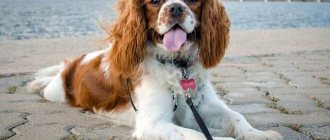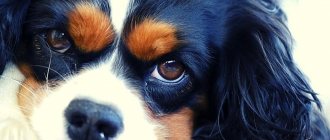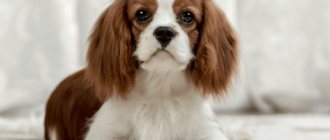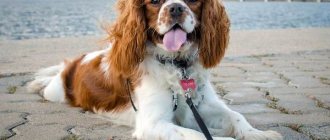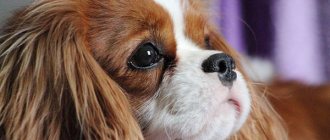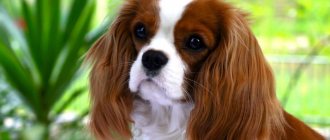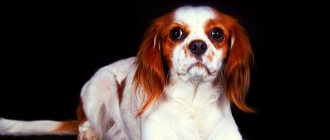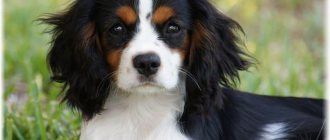The Cavalier King Charles Spaniel is an adorable, shaggy little fidget just waiting to jump on your lap or curl up on your sofa cushion. This is a small decorative dog, it is also often called a “sports toy”. Like every athletic breed, the Cavalier loves active games and sports activities such as rallying, agility, long hikes and flyball. Despite all their external decorativeness, dogs of this breed will happily hunt feathered game and will chase chipmunks, squirrels and colorful butterflies. Where did these playful companion dogs with incredibly beautiful exteriors come from? What should you be prepared for when choosing a Cavalier King Charles Spaniel as your pet? What are the weak points of this breed and how to avoid them when choosing a puppy? How to correctly create a menu for a little tomboy? Is it difficult to care for? Find answers to these and other questions in our article.
History of the origin of the breed
The German FCI standard contains no information about the origin of the breed. It only states that the country of origin is Great Britain. Therefore, we will build on the information that is available in open sources. Dogs similar to modern representatives of the breed lived in the noble and royal courts of England, France and Scotland back in the 16th century. The breed received the prefix Charles thanks to Charles I, the king of England, Scotland and Ireland, who was kind to these little spaniels.
Unfortunately, not all monarchs liked gentlemen; during the reign of William IV, pugs and spaniels came into fashion. The ruler liked flatter-faced dogs. The dogs that adorned royal portraits dating back to the 16th and 17th centuries have all but disappeared. The breed owes its restoration to one rich American. Roswell Eldridge was very fond of spaniels from paintings of the 16th, 17th and 18th centuries. He promised a good reward to those breeders who could restore this breed.
British breeders coped with the task - they received the prize in 1928. Roswell Eldridge himself did not have time to see the result of their breeding activities; the American died a month before the exhibition at which the recreated spaniels were presented to the world. In 1945, the Cavalier King Charles Spaniel was created as a separate breed. And in 1955 it was recognized by the European federation FCI.
Description
The now popular image of representatives of the royal breed was created as a result of breeding experiments by Roswell Eldridge (USA) and his English associates in 1926. He restored the original distinctive external characteristics of the cavalier.
A more refined and graceful female, which weighs no more than 5.5 kg, is much lighter than a male with a weight reaching 8 kilograms. Height varies from 30.5 to 33 cm.
Expert opinion
Anna Abramenko
An avid dog lover. Experience in veterinary medicine since 2009.
Ask a Question
It should be noted that size does not influence the implementation of exhibition examination. The main role is played by harmony and compliance with the description of the breed.
Description of the Cavalier King Charles Spaniel breed
The Cavalier King Charles Spaniel is an active, graceful dog with correct balanced proportions and an attractive exterior. Animals are loving, positive, friendly and never show aggression or unreasonable excitability.
The breed belongs to the category of indoor and decorative companion dogs. It should be distinguished from its related breed, the King Charles Spaniel. To learn this, let's look at the basic characteristics of a dog.
Characteristics
The hunting and guarding instinct, which is a feature of Charles Spaniels, has now been practically lost. These dogs have become friends and companions, which does not allow them to be used as property protectors.
Their characteristic is intelligence. These are very smart pets with whom even gentle people without leadership qualities easily find contact.
Breed standard
Exterior features according to the European breed standard FCI
- Body type . Harmonious, well balanced.
- Back . Smooth, straight.
- Lower back . Shortened.
- Breast. The ribs have a pronounced bend.
- Limbs. With moderate bone. The front ones are straight. The hind ones have a clearly marked knee joint.
- Paws. Compact. The pads are dense. They have rich fringe.
- Gait. Sports. Movements are elegant and free. Parallel arrangement of limbs during movement.
- Neck. With a bend, moderate length.
- Head. Wedge-shaped.
- Scull. Absolutely even and flat between the ears.
- Muzzle. Shallow stop.
- Nose. The nostrils are well formed. Black color.
- Jaws. The bite is a perfect scissor bite. The jaws are developed.
- Ears. Set high. Long, hanging. With beautiful fringes.
- Eyes. Round and large, without bulge. Widely spaced.
- Tail. Balanced length. Well planted. While the dog is moving, it wags happily.
- Coat . Long, silky, but without signs of curl. A small wave is allowed. There should be beautiful fringes.
- Color. The standard allows four colors: black (raven wing) with red tan, ruby (mahogany), blenheim (pearl white background and chestnut spots), tricolor (black, white and tan). Other combinations and colors are considered breed defects.
- Weight. On average - 5.4-8 kg.
- Height at withers . There is no breed standard. On average - 32-34 cm.
- How long do they live ? The average life expectancy is 12-13 years. In history, cases of longevity have been recorded - 15-17 years.
Breed characteristics
It’s not for nothing that gentlemen are called comfort dogs. These cheerful dogs are always in a good mood and are ready to share it with the whole world. Dogs are always cheerful, trusting, playful and maximally open to communication with humans. They want to always be close. If a person feels bad or sad, the Cavalier King Charles Spaniel will be nearby, most often on his lap. With dogs like these, you don't need cats!
The breed's character is incredibly social. This means that gentlemen are inclined towards friendship and communication not only with their owner. They will get along with all people who come into the house. They will make friends with other pets and will be happy with everyone they accidentally meet on a walk. This is the main advantage of the breed, but at the same time a disadvantage. Dogs cannot be left alone. It is important that there is always someone else in the house where they live. When alone, gentlemen go crazy due to their increased level of anxiety.
Dogs are ready to follow on the heels of the owner, accompanying him from the kitchen to the bedroom, will keep company in the bathroom, and will protect the sleep of the household. Cavaliers have highly developed intuition, which makes them excellent “therapy dogs.” They are ready to sit quietly for hours with older people or kids, but with active children and adults they will become noisy friends.
The dog's temperament is usually calm, but some representatives of the breed can be stubborn. Smart dogs quickly understand how to manipulate people - this is not difficult to do, given the dog's cute exterior and large, expressive eyes. The owners will have to show perseverance and strength of character when charming beggars beg for food from the owner's table.
Dogs are very active and athletic, and by nature they love to chase moving objects. The ancestors of the cavaliers were used for hunting, so the pursuit of everything that seems to be prey sits in the heads of the dogs at the level of instincts. You will have to keep your pets on a leash while walking so that they do not run away after a bird, butterfly, cyclist or car.
Character
The main goal of a Cavalier King's life is to be close to his owner. This little dog is very attached to all family members, she loves to be the center of attention, needs communication and a lot of company. Loneliness is unacceptable for the friendly Charles Spaniel. The ideal environment for representatives of the species is a large large family.
The gentleman gets along well with children. He patiently endures everything that kids do to him, even if it's riding in a doll's stroller. Gets along with pets. Treats strangers with caution and distrust. In order for a friendly disposition to develop, the spaniel must get used to a stranger. Aggression is not in the nature of this species.
No guard from the Cavalier King. He cannot be a guard due to his lack of aggressiveness and friendliness. Although, if you are rude to him, the dog may bite. The spaniel barks loudly and for a long time if he is left alone in the house. So, if possible, provide company for your pet or take it with you. It is worth noting that representatives of the breed love to travel and tolerate moving well.
Care and maintenance
The Cavalier King Charles Spaniel is considered an unpretentious breed that quickly adapts to various living conditions. They are not difficult to care for, so the dogs are suitable for those who have decided to take their first pet into their home. Even older people can cope with them, provided that they are always at home.
Content Features
As we have already said, gentlemen are unpretentious. For dogs to feel happy, one thing is necessary - a sufficient portion of the owner’s attention. The Cavalier King Charles Spaniel wants to be with people all the time; without human attention, the dog becomes very sad. This is the main thing you must ensure to maintain it. If you are forced to leave your dog at home alone, give up this idea. Nothing good will come of it anyway. Find another breed!
If you still sometimes have to leave your pet at home alone, accustom him to an enclosure from puppyhood. The aviary must be equipped at home. This could be a spacious cage. This way you will save your home from the destructive behavior of a bored gentleman. But keep in mind that the dog should only be in the enclosure when no one is home. Do not use it to punish your pet by placing it there in your presence. Otherwise, the dog will have one more phobia. You don't need it!
The second thing that is important to consider is that these are not street dogs. These pets are only taken outside for exercise. Cavaliers feel great both in a country house and in city apartments, but conditions must be created there for the pet to live comfortably. The floor should be carpeted or carpeted. On a slippery floor, dogs' paws move apart - this provokes the development of incorrect paw placement and spoils the gait.
Dogs fully realize their physical activity at home. The gentlemen are walked twice a day for 30-40 minutes; longer walks tire them. It is advisable to walk not on asphalt surfaces, but on the ground, so that the dogs’ paws do not get tired. In crowded places and near the road, be sure to use a leash to curb your pet's pursuit instinct .
Gentlemen love toys. Moreover, they usually choose their own toy. This could be your slipper, old sneakers or an ordinary rag. Have a box of toys for your dog. There you can put toys from the pet store and those that the dog chose for himself to play with. It’s better to give the gentleman one slipper to be torn to pieces than to scold him every day for chewing his shoes.
What does care consist of?
The Cavalier King Charles Spaniel does not need to be trimmed. Moreover, dogs with haircuts are not allowed to participate in exhibitions and competitions. The only place where hair is allowed to be clipped is between the toes. This is done solely for hygienic purposes. Therefore, grooming a gentleman consists exclusively of combing. Dirt easily falls off the dog's silky coat.
Weekly brushing will only be required during the shedding season. Outside the shedding period, it is enough to brush the dog 1-2 times a week. Particular attention should be paid to fringes with decorating wool. These areas are carefully combed first with a comb and then with a brush with natural bristles so that tangles do not form.
Cavaliers are bathed when necessary, and show-class dogs are also bathed before exhibition events. For water treatments, care products from pet stores are used. The permissible water temperature for swimming is 39°C. After bathing, dogs are dried with a terry towel and dried using a hairdryer. It is forbidden to dry the dog by wrapping it in a towel - this causes the fur to dry out, which leads to further hair loss .
The dog's ears also require special care. They are long and densely covered with hair. And their hanging position does not allow the ears to actively ventilate and provokes the accumulation of dirt and earwax. To prevent your pet from having problems with his ears, they are regularly examined and cleaned of dirt with a damp cotton pad. It is unacceptable to use aggressive agents (hydrogen peroxide) to clean the ears. Ear drops or warm boiled water will do.
Wipe your eyes in the morning to remove any secretions that have accumulated overnight. This is best done with a cotton pad soaked in chamomile infusion or boiled water. If the eyes become red or purulent discharge appears, the dog is taken to the veterinarian. There is no need to self-medicate and wash your eyes with folk remedies without a doctor’s prescription.
Puppies are taught to brush their teeth from a very early age so that they can easily tolerate this procedure as adults. Teeth are brushed with a special brush and toothpaste 2 times a week. Nails need trimming 2 times a month. This must be done carefully so as not to damage the blood vessels.
Read more:
- how to brush your teeth;
- how to trim claws.
Pros and cons of the breed
The Charles King Spaniel is suitable for everyone, both an experienced dog owner and a beginner. The Toy Spaniel can become an ideal companion for an elderly person, a cheerful playmate for a child, and simply a devoted pet for the whole family.
If you liked the King Charles Spaniel, you should familiarize yourself with its advantages and disadvantages.
The main advantages of a toy spaniel:
1. Beautiful exterior. 2. Friendly disposition. 3. Loves children. 4. Suitable for keeping even in a small apartment. 5. Inexpensive content. 6. Gets along well with other pets.
Health
The breed was artificially restored, so dogs may have certain health problems, both genetic and non-hereditary.
Genetic pathologies
- Pathology of the mitral valve. Progressive mitral valve disease often appears in dogs of this breed at the age of 5 years. It is expressed in the fact that the heart valve gradually thickens and degenerates, and begins to leak. Manifested by heart murmurs. Requires constant maintenance therapy and monitoring by a cardiologist.
- Syringomyelia (Chiari syndrome). A disease of the nervous system that is inherent in the Cavalier King Charles Spaniel breed to a greater extent than in other breeds. Congenital pathology is characterized by bone deformations in which the back of the skull is too small. This leads to the appearance of cerebrospinal fluid-filled cavities in the spinal cord. Dogs may experience pain, squeal and bark for no reason. In mild cases, no treatment is required; in complex cases, euthanasia is required.
- Dislocation of the kneecap. The pathology is characterized by instability of the knee joint. Either one or both cups may be unstable. The condition is accompanied by pain and can bring discomfort and suffering to the dog. In mild cases, no treatment is required; in severe cases, surgery is required.
- Hip dysplasia. Congenital pathology of the development of the hip joint is common in dogs of all breeds. It manifests itself as gait instability, decreased range of motion, and pain. Treated with medication or surgery.
Tendency to other diseases
In addition to genetic health problems, dogs of this breed also have:
- Primary secretory otitis media (PSOM). Some experts call this pathology otitis media with effusion. The disease is characterized by the appearance of a mucus plug in the tympanic cavity. In dogs, it manifests as ear itching, scratching, vestibular disorders, facial paralysis, convulsions, lethargy, and hearing loss. Accurate diagnosis (MRI, CT) is required. The disease is treated with surgery and further drug therapy.
- Juvenile cataract. Characterized by clouding of the lens of the eye. Appears in puppyhood. Depending on the form of the disease, it can either be completely cured or lead to complete blindness of the animal.
- Allergy. Representatives of the breed often have food allergies. Careful attention to diet planning is required.
Important!
When choosing a Cavalier King Charles Spaniel puppy, ask the breeders for genetic test results.
History of appearance
The origin story of the Cavalier Charles Spaniel goes back a long way.
It is generally accepted in the world that the creator of the breed is the king.
But the very first spaniels had a completely unroyal appearance; they were much larger and rougher. Their main purpose was to help hunters. Of course, we didn’t go hunting big game with this spaniel, but when hunting birds, the gentleman turned out to be a useful assistant and demonstrated an excellent sense of smell, complete fearlessness and mobility.
The breed was first mentioned in the 13th century. And already in the 15th century, the Charles King Spaniel reached the peak of popularity.
The birthplace of the breed is considered to be Great Britain. But exactly how these dogs originated is not known exactly. There is an assumption that tiny spaniels were brought to the country by the Celts back in the 9th century. Or the cavaliers - descendants of the Pekingese - arrived in Britain in the same 9th century, but from China.
Over time, they took a closer look at spaniels and appreciated their beautiful coat, expressive eyes, smooth lines and curves. Specialists began to work on the breed purposefully, and as a result of this work, the appearance of the dogs underwent significant changes.
The animals decreased in size, their muzzles shortened, and their noses became flattened. The new dog ceased to be a hunter, she confidently entered the royal palaces and houses of noble people as a beautiful decoration and took a strong place there. Pets looked great in living rooms, lying on sofa cushions, and were more than once captured by artists on canvases next to their eminent owners.
Animal figures were also sculpted from clay. Works of art that have survived to this day are very popular among connoisseurs.
It is known that Charles Spaniels were bred directly in palaces.
Small puppies, which could already be weaned from their mother, were given to servants. Specially trained servants trained the dogs and instilled in them good manners.
The breed got its name thanks to the monarchs, whose favorites it was.
With his master, Charles I, the spaniel was in prison for a long time. He was also present at the execution of his beloved owner. And Charles II (in English this name is both written and pronounced as Charles) by a special decree allowed these dogs to be allowed into any place.
Photo: https://pixabay.com/photos/dog-spaniel-cavalier-king-charles-634031/ After the death of the king, the popularity of spaniels began to fade, and pugs attracted the attention of the nobility. At the beginning of the 20th century, there were catastrophically few representatives of this breed left. But there were enthusiasts who managed to revive dogs. In 1928, the first breed standard for the Cavalier Charles Spaniel was developed in Great Britain.
Training
The breed is smart and quick-witted, so they begin training and education right away. Cavalier puppies are able to understand and remember commands as early as 8 weeks. There is no need to wait until the dog is six months old - at 6 months the puppy will have already learned to shirk activities that he does not like and to be stubborn. You can train a puppy at home, or you can bring him at 10-12 weeks to a puppy training class at a kennel club.
There are some nuances in training small breed dogs that need to be taken into account. It is imperative to take into account the breed characteristics and temperament of your pet. Cavalier training is best done in the form of an exciting game. If the puppy thinks that he is being played with fun, he remembers commands faster and more willingly and fulfills the owner’s demands.
The first thing a puppy is taught is his name, the name of the owner and all family members. The remaining commands are started only when the puppy gets used to the new home and responds to its name. The basic set consists of the commands: “Come to me!”, “You can’t!”, “Near!”, “Ugh!”. Knowing these commands will make your walks with your pet safe.
During training, it is unacceptable to shout or physically punish the puppy . Praise him if he followed the command, treat him with a treat for it. Cavaliers are sensitive to praise and crave love and affection from their owner - take advantage of these features during training.
Training tips from owners
- When the puppy came up to you on the command “Come!” Never immediately fasten his collar. First, give him a treat and play with him. The dog should associate this command with something pleasant.
- If the dog is playing and does not hear the command “Come to me!”, hide behind a building or tree. This will teach him to watch you and not lose sight of you.
- To teach your dog to walk next to your left leg, always keep a treat in your left pocket.
- The command “No!” you need to give it loudly in a sharp and stern voice, but do not shout. As soon as the puppy stops the unwanted action, he is rewarded and praised.
- To practice the “Near” command, it is best to use a leash with a collar, rather than a harness. During training, the leash should sag; there is no need to tighten it too much. If the puppy pulls on the leash, he is given a command and pulled sharply towards his leg.
Training and education
An undoubted advantage of representatives of the breed is the lack of stubbornness, which is characteristic of most others. Innate obedience and devotion to the owner facilitate the training process, but an important condition for successful education is its timely start. This should be done from the moment the puppy arrives in the house.
Initially, you need to stop the puppy’s attempts to chew furniture, other property, climb into the bed, and steal food. This behavior is natural at an early age. Stopping such actions will teach the puppy to recognize the authority of the owner. After this, you can start learning basic commands: me, fu, others. You can start doing this from the age when active walks began - after all vaccinations.
Lack of stubbornness, high intelligence, and quick learning ability make it possible to complete any training course offered by dog handlers.
What and how to feed
To feed Cavalier King Charles Spaniels, you can use both a natural diet and commercial feed.
Natural diet
The natural diet consists of:
- raw lean beef, rabbit or lamb;
- boiled turkey or chicken breast;
- offal (kidneys, heart, chicken stomachs, udder, liver);
- tripe, rennet;
- lean boiled fish, preferably sea fish;
- raw quail eggs – 2-3 pieces 1-2 times a week;
- low-fat fermented milk products (cottage cheese, kefir, natural yogurt or fermented baked milk);
- brown rice or buckwheat;
- vegetable oil (olive, sunflower) – 1 teaspoon per day;
- seasonal vegetables, fruits and herbs.
It is strictly forbidden to give:
- raw pork;
- sausages and canned food;
- pickles and smoked meats;
- fatty dairy products;
- raw fish;
- bird and rabbit bones;
- soybeans, peas;
- baked goods;
- chocolate.
From the age of 6 months, the dog needs only two meals a day. To calculate the daily serving volume, the dog's weight is multiplied by 5%.
Industrial feed
When choosing a ready-made diet for your gentleman, you need to give preference to brands of the “super-premium”, “premium” and “holistic” classes. This is the only way you can provide your pet with balanced, high-quality nutrition that will ensure good health for the dog. The daily feeding rate is calculated in accordance with the manufacturer's instructions on the packaging.
Best food for Cavalier King Charles Spaniel:
- Piccolo Small Dogs Salmon & Venison – for small breeds, with venison and salmon;
- Acana Heritage Adult Small Breed Grain-Free – grain-free holistic for small breeds of dogs;
- Grandorf Adult Mini 4 Meat & Brown Rice Hypoallergenic - hypoallergenic formula for small dogs with brown rice;
- Guabi Natural Adult Dog Mini – complete food for dogs weighing up to 10 kg;
- Royal Canin Cavalier King Charles Adult – specialized food;
- Brit Care Adult Small & Medium Salmon & Potato Grain Free – for miniature and small dogs.
Important!
With any type of diet, dogs should have clean, fresh water available around the clock. Water for dogs should be filtered or bottled.
Nutrition
Organizing a diet based on professional feed is considered the most convenient. They contain all the elements and vitamins necessary for life.
Varieties are selected based on the age and health status of the pet. It is recommended to give preference to the premium class. For puppies, the daily intake is divided into five servings. Adults are fed in the morning and evening.
If the dog was initially accustomed to a natural diet, only products that are healthy for its body should be used. The basis is lean meat. Veal is given raw, but turkey or lamb should be boiled, like offal.
The menu includes buckwheat or rice porridge, low-fat cottage cheese, kefir, and vegetables. Vitamin and mineral supplements prescribed by a veterinarian help balance the diet. Two eggs are fed for a week. Bones, sweets, smoked meats, and baked goods are prohibited.
Expert opinion
Anna Abramenko
An avid dog lover. Experience in veterinary medicine since 2009.
Ask a Question
The weight of a newborn spaniel is only 350-500 grams.
With properly organized nutrition, it grows quickly:
| Weight by month, kg | Age in months |
| 2-3 | 1 |
| 6-9 | 2-6 |
| 7-12 | 6-12 |
Photo
Black and Tan
The dogs are raven (black) with bright red tan markings. The tan marks have a clear shape and are located on the chest, limbs, under the tail, on the cheekbones, above the eyes and on the inside of the ears. White spots are not allowed.
Blenheim
The dogs are pearly white with distinct chestnut spots. A white diamond on the crown indicates that it belongs to this breed.
Ruby (mahogany)
The solid color is bright red with a hint of mahogany. White spots are not allowed.
Tricolor
The main background is pearl white. There are black spots on it. Red tan marks are located on the eyebrows, cheekbones, chest, paws and inner surface of the ears. Between the eyes there is a wide white stripe extending onto the forehead.
Owner reviews
Alexander : “The Cavalier King Charles Spaniel breed is incredibly affectionate, constantly cheerful, and loving. Children love to play with the dog. This is a real source of good mood and a fighter against sadness in the house. You won't get bored with him! I definitely recommend it to everyone, but I strongly urge you to choose your puppy responsibly. Don't take the first one you get. Dogs are not cheap, so don't try to save money on your purchase. This savings will come back to haunt you later. The breed has many genetic diseases. When buying from unscrupulous breeders, there is a huge risk of buying a sick animal. Then you’ll get tired of paying for your dog’s examinations and treatment.”
Natalia : “My Zhorzhik is very homely, very affectionate, very tame and kind. Just some kind of charming toy, only alive. We quickly mastered basic commands with him, even taught him to change his diaper at home. His grandmother spends most of his time with him; she cannot always take the dog out for a walk. In the evenings, his eldest son walks with him, the dog obeys him. We feed him dry food, but we can give him a piece of apple or carrot as a reward. He so touchingly asks for a treat - you have to see it once!”
Timur : “Dogs have a huge disadvantage - they trust all people. Anyone can take away such a cute face. I want to urge all owners to be careful! Puppies are expensive, and attackers often take advantage of the affection and friendliness of gentlemen. Take care of your pets!”
Video reviews from owners:
Other dog breeds
Before you decide to get this spaniel, study its character and habits, talk to other breed owners and reputable breeders to learn more.
If you're interested in similar breeds, check out their profiles to compare the pros and cons:
Boykin Spaniel
Japanese Chin/Chin (Japanese Spaniel)
Clumber Spaniel
Tibetan Spaniel
English Cocker Spaniel
There are many breeds of dogs, with careful research you can find a pet that suits you and bring it into your home.
How much does a puppy cost?
Cavalier King Charles Spaniel puppies in Russian nurseries are not cheap. The cost starts from 30,000 and can reach 85,000 rubles.
The cost depends on many factors, but most of all it is influenced by belonging to a certain class:
- Pet class will cost 40,000 – 45,000 rubles.
- Breed class can be purchased for 60,000 – 70,000 rubles.
- Show class costs from 75,000 rubles.
In markets and on advertisements on sales boards, puppies of this breed are offered for 30,000 - 40,000 rubles.
In Ukraine, the price for Cavalier King Charles Spaniel puppies varies from 6,000 to 35,000 UAH.
How to choose a puppy
Cavalier King Charles is a common breed. Finding a puppy is not difficult. In order not to make a mistake with your choice, it is recommended to carefully choose the place of purchase. Buying a dog secondhand, especially without documents, is very risky. If you want to purchase a pet that will participate in exhibitions, competitions, and other events, you must have documents. This is not the biggest drawback of such a purchase; puppies from an unreliable source are often characterized by soreness and mental disorders. Sometimes after a while it turns out that the spaniel is not purebred at all.
When purchasing, it is also important to find out:
- origin;
- pedigree;
- who the parents were, their achievements;
- what was the care like from birth;
- what vaccinations have been given?
By taking the time to choose, you will be able to acquire a healthy, strong, loyal friend.
It is better to choose nicknames before the puppy arrives in the house, in order to immediately accustom the pet to them. For a girl, Dolly, Trixie, Floris, Lizzie are suitable, for a boy - Neil, Ramon, Casper, Robie.
The following are the advantages and disadvantages of the breed:
| + | – |
| Lack of stubbornness, high intelligence, quick learner | Intolerance to prolonged separation from owner |
| Attractive appearance, proportional appearance | Lack of proper care for hair, ears, eyes provokes diseases |
| Ease of care and maintenance | Not long-lived |
| Loves children and gets along quickly with new people | |
| Suitable for living in an apartment or private house | |
| Not picky about food |

